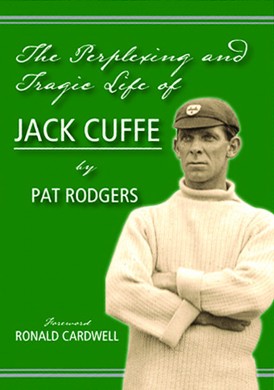The Perplexing and Tragic Life of Jack Cuffe
Martin Chandler |Published: 2021
Pages: 112
Author: Rodgers, Pat
Publisher: The Cricket Press Pty Ltd
Rating: 4 stars

It was back in 1903, at the age of 22, that Jack Cuffe left Australia to try and forge a career as a professional cricketer in England. He left behind in Sydney a wife and a six week old daughter, who he did not bother to inform of his intentions. He never saw them again.
With but a single undistinguished appearance in Australia behind him Cuffe did well to persuade Worcestershire to offer him a ten year contract. His medium paced left arm bowling was Cuffe’s strongest suit, but he was a good enough batsman to do the double in 1911, so whilst he was never in the front rank of county cricketers Worcester would have been happy enough with their investment.
Once he settled in England Cuffe married again, bigamously (as in time did his Australian wife), and had five more children. We know the second Mrs Cuffe had serious mental health problems, but her ultimate fate is unknown. In 1914 Cuffe enlisted in the Worcestershire Regiment, and was not discharged until 1919.
In 1922, by then a professional with Todmorden in the Lancashire League, Cuffe married for a third time, his new wife being prepared to take on not only a man ten years her senior, but also the responsibility of his five children.
His career as a League professional over Cuffe spent the summers of 1925, 1926 and 1927 on the First Class umpires list. After that he did some coaching at The Wrekin school in Shropshire and, in 1931, was successful in an application to become cricket coach at the renowned cricketing nursery at Repton College. Two days after he arrived in Repton Cuffe disappeared, and eleven days after that a body was recovered from the River Trent, some five miles from Repton.
The cause of death was drowning, and it was established that Cuffe had taken his own life. There was no note however, and no obvious explanation for Cuffe’s suicide. Naturally shocked and horrified at the turn of events the third Mrs Cuffe was unable to understand the conclusion her husband’s inquest came to.
And that dear reader, is the bare bones of Jack Cuffe’s life and tragic death. David Frith had a look at it in his two excellent books on cricketing suicides but that, until historian Pat Rodgers had his interest piqued by Frith’s account, was where it was left.
It transpires that Cuffe’s father died in an asylum at 34, Rodgers having located his medical records. After that impressive find it is difficult to imagine that any stone was then left unturned in terms of looking at Cuffe’s life in Australia and telling that story. Rodgers then changes hemisphere’s with his subject and reconstructs his life in England before, in his book’s closing chapters, his research enables him to add contributions from a number of Cuffe’s descendants.
The evidence that Rodgers gathers is an impressive dossier given that Cuffe died the best part of a century ago. It provides much food for thought, though no definitive explanation. The precise answer to the question of why Cuffe took his own life will never be known, but Rodgers has taken the step of consulting Greg de Moore, whose thoughts close the book. De Moore is a cricket writer himself, having written a biography of Australian ancient Tom Wills, but Rodgers involved him in his researches for another reason. In his day job de Moore is an Associate Professor of Psychiatry.
The Perplexing and Tragic Life of Jack Cuffe is a fascinating study, and I certainly hope it will be the first of a number of such books from Pat Rodgers. I hope too that he sticks with his publisher who has, as always, done a superb job. Printed on high quality paper the book is well designed, impressively illustrated and closes with some useful statistics and an excellent index.






Leave a comment